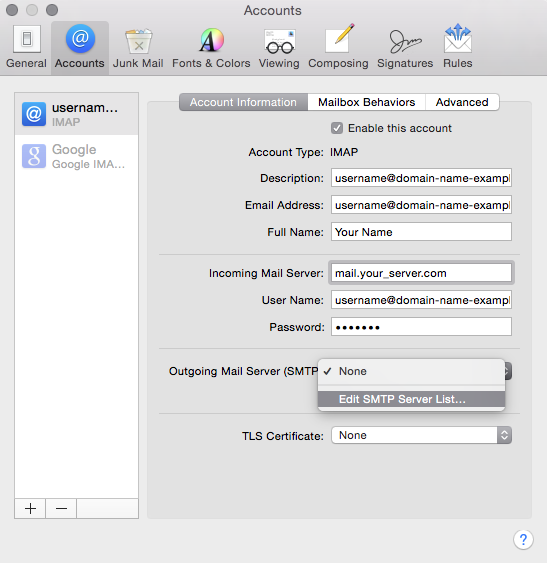
- #Os x mail tls certificate how to#
- #Os x mail tls certificate full#
- #Os x mail tls certificate code#
- #Os x mail tls certificate windows#
This method is sometimes called SSL/TLS to signal to people who know the older name that it's the same thing here, let's just call it TLS.) (TLS is the modern name for SSL, the preceding standard. TLS stands for transport layer security, and in common use it's a method of combining the advantages of public-key cryptography, external third-party (out-of-band) validation, and per-session encryption. Secret handshakesĪ digital certificate comes in the form of server-side TLS certificate.
#Os x mail tls certificate how to#
Then I'll describe how to get a free certificate from StartCom as a simple case, before giving a few examples of how to install your certificates. I'll start with an explanation of how digital certificates create encrypted sessions. There can be something technically imposing about getting and installing a digital certificate, even though it has a high utility value, so I'm here to make it easier by breaking it down into steps that someone without encryption and command-line knowledge should be able to work with. For remote email access, SSL/TLS is simpler and more straightforward, and you don't have to compromise on protection in the process. While I recommend VPNs, they aren't always the practical, affordable, or correct solution.

With so many people accessing networks over WiFi or other untrusted networks for an increasing number of different kinds of services-calendars, contacts, Webmail, email, and so on-encryption is a must, whether via a VPN or by securing services one by one. That's a broad statement, but it holds true no matter how you slice it. If you can get access to an Apple Account Manager, please pile on the pressure and request them to support EAP Chaining.Anyone operating a server on any scale should want a digital certificate to encrypt data between clients and services, whether for personal, office, or public use. If Macbooks are joined to the Active Directory domain, there's apparently a way to use the passive identity scraping as an alternative method to achieve the same. Works for us with docking stations or Ethernet dongles This is a technical solution, not a user experience solution.

And "/Domain Users" is a group you've got in ISE from your AD that you can reference in policy. In Macbook AuthZ policy #2 above, "YourOrgActiveDirectory" is the Active Directory you've configured in ISE in the External Identity Sources.
#Os x mail tls certificate full#
CWA Dictionary in ISE has limited options so don't expect a full set of attributes you can match.

They've put up with it so far, but its unpopular. It's a poor user experience for the Macbook users.
#Os x mail tls certificate windows#
It's not transparent like Windows + NAM, and any time the Macbook Ethernet goes down, another CWA logon has to be performed. And because we can stitch together the user ID (gleaned from the redirect to the portal with the previous match of policy that got them there), we kind of get the same functionality as NAM+EapChaining - but much less elegantly. Isn't limited to Domain Users.īecause the machine presents our cert, can can assume its one of ours. We build on that logic by having policies per department/division, and each get a AuthZ policy and different SGT. The policy looks like CWA-CWA_ExternalGroups EQUALS ( YourOrgActiveDirectory:/Domain Users)Īnd obviously, in the policy set, #2 has to be above #1 for it to work in the correct sequence. You can then match the user ID entered into the central web auth portal to an AD group. Macbook AuthZ policy #2 - User logs into CWA portal. If matching this ISE policy, we redirect to a portal on ISE (same technique for guest wireless portal). Our Macbooks configured via MDM to present our machine-certs on LAN. Macbook AuthZ policy #1 - can't match EAP-Chaining policies, so next in our ISE policy sets we look for Dot1X authentication (machine certs) that have been issued by our PKI. We have all our EAP Chaining policies at the top that Windows + NAM computer hit. I SE Policy Logic for Wired authentications Macbooks- Ours are not joined to the domain, but do have a machine certificate installed via our MDM.

We aim to do this for Macbooks and their users too. Our Windows fleet has Anyconnect + NAM, configured for EAP Chaining, works splendidly for identifying a trusted computer on boot up, and then when a user logs on, reauth-ing to get a user-based AuthZ profile from ISE to elevate to user-centric permissions.
#Os x mail tls certificate code#
ISE playing pivotal role, running v3 now but this also applied to later 2.x code for us. Our environment - Windows and Macbooks, Cisco Trustsec infrastructure, mix of traditional network and SD-Access. Just sharing what we do in case it helps anyone. The old when will Apple support EAP Chaining dilemma.


 0 kommentar(er)
0 kommentar(er)
